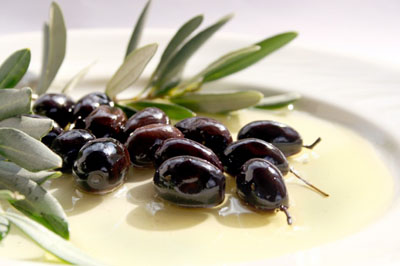
Olive Oil History
Homer called it “liquid gold.” In ancient Greece, athletes ritually rubbed it all over their body. Its mystical glow illuminated history. Drops of it seeped into the bones of dead saints and martyrs through holes in their tombs. Olive oil has been more than mere food to the peoples of the Mediterranean: it has been medicinal, magical, an endless source of fascination and wonder and the fountain of great wealth and power. The olive tree, symbol of abundance, glory and peace, gave its leafy branches to crown the victorious in friendly games and bloody war, and the oil of its fruit has anointed the noblest of heads throughout history. Olive crowns and olive branches, emblems of benediction and purifiation, were ritually offered to deities and powerful figures: some were even found in Tutankhamen’s tomb.
Cultivating the Sacred
Olive culture has ancient roots. Fossilized remains of the olive tree’s ancestor were found near Livorno, in Italy, dating from twenty million years ago, although actual cultivation probably did not occur in that area until the fifth century B.C. Olives were first cultivated in the Eastern part of the Mediterranean, in the region known as the “fertile crescent,” and moved westwards over the millennia.
Beginning in 5000 B.C. And until 1400 B.C., olive cultivation spread from Crete to Syria, Palestine, and Israel; commercial networking and application of new knowledge then brought it to Southern Turkey, Cyprus, and Egypt. Until 1500 B.C., Greece—particularly Mycenae—was the area most heavily cultivated. with the expansion of the Greek colonies, olive culture reached Southern Italy and Northern Africa in the eighth century B.C., then spread into Southern France. Olive trees were planted in the entire Mediterranean basin under Roman rule. According to the historian Pliny, Italy had “excellent olive oil at reasonable prices” by the first century A.C, “the best in the Mediterranean,” he maintained.
In the land of the Hebrews, King Solomon and King David placed great importance on the cultivation of olive trees; King David even had guards watching over the olive groves and warehouses, ensuring the safety of the trees and their precious oil.
Olive trees dominated the rocky Greek countryside and became pillars of Hellenic society; they were so sacred that those who cut one down were condemned to death or exile. In ancient Greece and Rome, olive oil was the hottest commodity; advanced ships were built for the sole purpose of transporting it from Greece to trading posts around the Mediterranean.
The belief that olive oil conferred strength and youth was widespread. In ancient Egypt, Greece, and Rome, it was infused with flowers and with grasses to produce both medicine and cosmetics; a list was excavated in Mycenae enumerating the aromatics (fennel, sesame, celery, watercress, mint, sage, rose, and juniper among others) added to olive oil in the preparation of ointments.
Olive trees have an almost titanic resistance, a vital force which renders them nearly immortal. Despite harsh winters and burning summers, despite truncations, they continue to grow, proud and strong reaching towards the sky, bearing fruit that nourishes and heals inspires and amazes. Temperate climactic conditions, characterized by warm dry summers and rainy winters, favor plentiful harvests; stone, drought, silence, and solitude are the ideal habitat for the majestic olive tree. Italy and Spain are now the most prolific producers of olive oil, although Greece is still very active. There are about thirty varieties of olives growing in Italy today, and each yields a particular oil with its own unique characteristics.
Olive Oil Properties
Sun, stone, drought, silence and solitude: these are the five ingredients that, according to Italian folk traditions, create the ideal habitat for the olive tree.
We treasure extra-virgin olive oil for its nutritional and salutary virtues. La Cucina Italiana reports that extra-virgin olive oil is the most digestible of the edible fats: it helps to assimilate vitamins A, D and K; it contains so-called essential acids that cannot be produced by our own bodies; it slows down the aging process; and it helps bile, liver and intestinal functions. It is also valued for its culinary virtues and organoleptic properties as well: flavor (sapore), bouquet (aroma), and color (colore)
Climate, soil, variety of tree (cultivar) and time of harvest account for the different organoleptic properties of different oils. Certain extra-virgin olive oils are blends of varieties of olives; others are made from one cultivar.
The European Community gives the following parameters:
Extra-virgin olive oil with perfect taste is oil of the highest quality; it has a minimum organoleptic rating of 6.5 out of 10, low acidity (1% or less), and is untreated.
Olive oil has a minimum organoleptic rating of 5.5, a maximum of 2% acidity and is untreated.
The production of all other olive oils involves treatments.
Extra-virgin olive oil is produced in all regions of Italy, except Piedmont and Val D’Aosta. The leading producers are Liguria, Tuscany, Umbria, and Apulia. Tuscany produces such a great assortment of extra virgin oils that many do not resemble each other. In Umbria, it is so widely produced that it would be hard to imagine the landscape without the abundance of olive trees. Apulia is home to an impressive one-third of Italy’s olive trees.
The price of extra-virgin olive oil varies greatly. Two factors are influential: where the olives are grown and which harvesting methods are implemented. Certain locations yield more bountiful harvests; consequently their oil is sold for less. Olive trees planted near the sea can produce up to 20 times more fruit than those planted inland, in hilly areas like Tuscany. It is in these land-locked areas that the olive trees’ habitat is pushed to the extreme; if the conditions were just a little more severe, the trees would not survive. Extra-virgin oils produced from these trees have higher organoleptic scores.
Good olive oil: www.aziendaagricolamatteucci.com
Leslie Halloran
Please check out my website at: www.lihdesigns.net
“A frog in the well does not know the sea.”- Japanese Proverb
